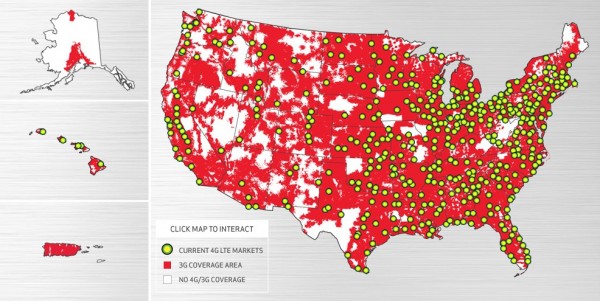Verizon lte coverage map suggests that Verizon is the largest LTE network in USA with 4G coverage in most part of United States. Providing LTE over 440 cities Verizon LTE network provide more LTE coverage then all other network combined. 80% of American population can access to Verizon’s 4G LTE network.
Verizon 4G LTE Coverage Map
Here are some facts about Verizon 4G LTE Network
The performance and capabilities of 4G LTE will be unmatched in the marketplace, allowing customers to do things never before possible in a wireless environment. Consider some of the advantages that Verizon Wireless’ implementation of 4G LTE will provide:
HIGHER DATA RATES:
With Verizon Wireless’ 10 + 10 MHz implementation, LTE will be supporting average data rates per user of 5-12 Mbps in the forward link, and 2-5 Mbps in the reverse link. Both maximum and average LTE data rates are significantly higher in the reverse and forward links than those supported by existing 3G networks. LTE will enable video application on the downlink as well as uplink – including, but not limited to video-sharing, surveillance, conferencing and streaming in higher definition than is possible with existing 3G technology today.
BETTER MULTIPATH, MOBILITY AND POWER PERFORMANCE:
The advanced radio characteristics of LTE address several issues that have traditionally crippled cellular wireless, including multipath and multiuser interference. LTE’s use of Orthogonal Frequency-Division Multiple Access (OFDMA) and multiple-input and multiple-output (MIMO) in the downlink transmission effectively eliminates intra-cell multiuser interference and minimizes inter-cell multiuser interference thereby maximizing performance. Similarly, the single carrier frequency-division multiple access (SC-FDMA) uplink transmission allows for user equipment to transmit low power signals without the need for expensive power amplifiers. Improvement in battery power consumption in end-user devices (UEs) is a side-benefit of the coverage and multipath/power performance advantages offered by LTE.
LATENCY:
The user plane latency achieved in LTE is approximately one-fourth the corresponding latency in existing 3G technologies, providing a direct service advantage for highly immersive and interactive application environments, such as multiplayer gaming and rich multimedia communications.
SIMULTANEOUS USER SUPPORT:
LTE provides the ability to perform two-dimensional resource scheduling (in time and frequency), allowing support of multiple users in a time slot, resulting in a much better always-on experience while enabling the proliferation of embedded wireless applications/systems. In contrast, existing 3G technology performs one-dimensional scheduling, which limits service to one user for each timeslot.
SECURITY:
LTE provides enhanced security through the implementation of Universal Integrated Circuit Card (UICC) Subscriber Identity Module (SIM) and the associated robust and non-invasive key storage and symmetric key authentication using 128-bit private keys. LTE additionally incorporates strong mutual authentication, user identity confidentiality, integrity protection of all signaling messages between UE and Mobility Management Entity (MME) and optional multi-level bearer data encryption.
SIMPLIFIED WORLDWIDE ROAMING:
Verizon Wireless’ chosen migration path to LTE, the widely adopted next-generation 3GPP standard, will provide the greatest opportunities for seamless international roaming.
MASS DEPLOYMENT:
LTE’s inherent support for Internet Protocol version 6 (IPV6) addressing and International Mobile Subscriber Identity (IMSI)-based identifiers makes mass deployments of machine-to-machine applications over LTE possible.

